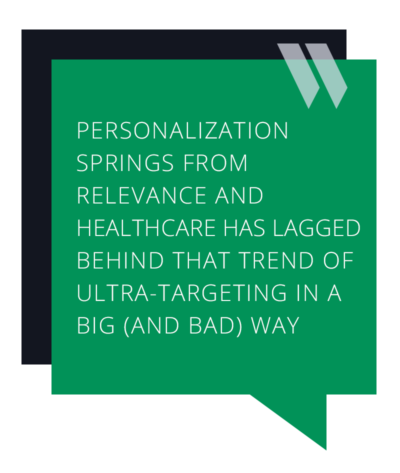Healthcare Portals Are Dead (And 3 Other Digital Healthcare Trends in 2022)
If 2020 was the proving ground for new healthcare mechanisms like telehealth or hybrid medicine, 2021 has shown just how fertile that soil has become. Venture investment in digital healthcare hit a breathtaking $15B peak in the first half of this year alone, more than doubling what was raised in 2020.
Enabled by digital technology, a new breed of healthcare services companies is emerging at a breakneck pace (wholly unsurprising given telehealth, the primary driver for this remarkable growth, is up 38 times over pre-pandemic levels).
So what will 2022 bring us? How will these fresh entrants to a well-established market with high barriers to entry continue to shake things up?
Here’s what I think will happen.
 Personalized medicine moves closer to being the norm
Personalized medicine moves closer to being the norm
This new cohort of companies is clearly interpreting “healthcare consumer” in a new way: by emphasizing the consumer part and taking a leaf right from ecommerce. As consumers of Amazon, Instacart, Uber, etc., every one of us is used to the personalization that’s so prevalent, it’s practically unremarkable at this point. Curated recommendations? Yes, please. Subscribe and save? Sure thing. A nudge to buy at just the right time? Well, isn’t that lucky, I guess I really need that new item right now. Personalization springs from relevance and healthcare has lagged behind that trend of ultra-targeting in a big (and bad) way.
Digital health startups will start solving for this equation in earnest in 2022, refining their approach to ensure that patients get the communications and care that make sense — at the time these elements are needed. And patients will reward them for it with greater loyalty and customer satisfaction scores.
Portals are the past, patient-facing apps the future
If you’re with an old-school provider (read: almost all the big healthcare systems you can think of), you’ve no doubt interacted with a portal powered by EMRs. At first blush, they raise patients’ hopes: Perhaps this will be an easier way to keep in touch with my clinician and stay current on my care. But once you log in for the first time, that hope quickly fades as you inevitably experience a clunky, confusing interface, old-school communication options, and the annoying investment of effort required to find useful information.
Instead, many providers we’re seeing at Welkin have a patient-facing app where — once again, in alignment with consumer expectations — the patient interacts on their terms with their care teams. More modern forms of communication — like SMS, email and chat — meet patients where they are and encourage back-and-forth connection with clinicians and relevant staff. And that increased communication could underpin much better compliance and health outcomes.
Say goodbye to stupid reminders and hello to basic marketing principles
Everyone’s care path is different. Yet we’ve all gotten reminders and emails that are clearly the result of a mass email effort (aka, spam) and not based on symptoms, test results, or your care team’s insights. Sure, benign updates (“Is it time for your dental exam?”) are mildly irritating but in the grand scheme of things, not that huge a deal. But imagine getting a more serious suggestion (“Have you scheduled your cancer screening yet?”) that makes you wonder if your provider saw something they failed to mention.
In consumer life, email blasts that are irrelevant and impersonal aren’t the way good marketing teams go to market; they know better and most do better. Healthcare companies need to take a leaf from B2C digital marketing playbooks to better segment and target patients to ultimately achieve much more optimal results. Digitally native healthcare entrants will have a very good shot at outpacing the more established providers. They’re substantially less encumbered by a “but this is the way we’ve always done it” mentality and much more well versed in emerging and modern digital methods to pique interest and conversions.
What do you see on the horizon for #digitalhealth in 2022?
About the Author:
Michelle Pampin is the CEO of Welkin Health, a Care Management platform focused on improving health outcomes for people living with chronic diseases. Michelle is an accomplished leader, with a track record of advancing high-growth Silicon Valley software companies. Michelle speaks three languages: Spanish, French and Portuguese. When she’s not busy leading Welkin, she is busy staying active with her Samoyed, Avi.
 Personalized medicine moves closer to being the norm
Personalized medicine moves closer to being the norm

